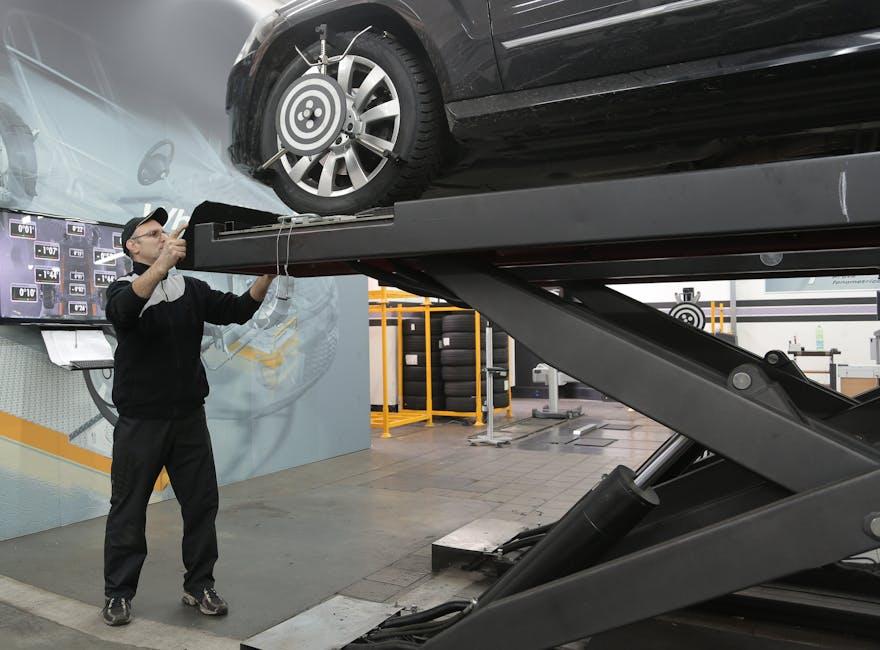Imagine setting off on a journey with your car perfectly aligned, every part working in harmony to deliver a smooth, safe ride. Yet, weeks or months down the road, you start to notice a subtle pull to one side, uneven tire wear, or a steering wheel that refuses to sit straight. These are not random mishaps but silent signals of misalignment, often rooted in something as simple—and as habitual—as your daily driving style. In this article, we delve into how common driving habits quietly chip away at your vehicle’s alignment, revealing the hidden connection between how you drive and the health of your wheels. Understanding this link is the first step toward preserving your car’s balance and extending its life on the road.
Table of Contents
- Common Driving Habits That Lead to Vehicle Misalignment
- The Impact of Rough Roads and Sudden Maneuvers on Alignment
- How Frequent Hard Braking and Sharp Turns Affect Your Wheels
- Detecting Early Signs of Misalignment from Your Driving Patterns
- Simple Adjustments to Driving Style to Prevent Misalignment
- When to Seek Professional Alignment Service for Optimal Vehicle Health
- Q&A
- To Conclude

Common Driving Habits That Lead to Vehicle Misalignment
Many drivers unknowingly adopt habits that contribute to their vehicle’s misalignment, leading to uneven tire wear and diminished driving comfort. Frequent abrupt stops and aggressive turns place excessive strain on the suspension components, gradually pushing the wheels out of their optimal positions. Additionally, consistently driving over potholes or rough patches without slowing down causes sudden jarring impacts that shift wheel alignment over time.
Other behaviors to watch out for include:
- Hitting curbs when parking or turning sharply
- Ignoring tire pressure irregularities, leading to uneven contact with the road
- Failing to rotate tires regularly, which can unbalance wear patterns
These everyday habits, while seeming minor, accumulate rapidly. Staying mindful and adopting gentle driving techniques can significantly extend your alignment’s stability and the vehicle’s lifespan.

The Impact of Rough Roads and Sudden Maneuvers on Alignment
Driving on uneven surfaces and reacting abruptly behind the wheel can silently sabotage your vehicle’s alignment. Each bump, pothole, or rock-edge encounter jolts the suspension system, gradually pushing wheels out of their optimal positions. Similarly, sudden swerves or sharp turns cause excessive stress on tires and suspension components, accelerating wear and tear. Over time, these factors not only compromise steering precision but also lead to uneven tire wear, reduced fuel efficiency, and a less comfortable drive.
Consider these common consequences of rough-road encounters and sudden maneuvers:
- Increased tire wear: Off-center wheels rub unevenly against the road surface.
- Steering difficulties: Wheel misalignment causes pulling to one side and erratic handling.
- Suspension damage: Shock absorbers and struts endure extra strain, reducing their lifespan.
- Fuel efficiency drop: Misaligned wheels increase rolling resistance, wasting fuel.
| Driving Event | Immediate Effect | Long-Term Impact |
|---|---|---|
| Hitting a pothole | Suspension jolt | Wheel misalignment |
| Sudden lane change | Sharp tire stress | Uneven tire wear |
| Rough gravel road | Constant tire abrasion | Degraded handling |

How Frequent Hard Braking and Sharp Turns Affect Your Wheels
When you slam on the brakes or whip the steering wheel abruptly, your wheels bear the brunt of the harsh maneuver. These actions put uneven pressure on your tires and suspension components, causing subtle shifts in alignment. Over time, these constant jolts make the wheels deviate from the manufacturer’s specified angle, resulting in uneven tire wear, reduced fuel efficiency, and compromised handling. Maintaining smooth, controlled movements not only enhances safety but also keeps your wheels balanced and aligned properly.
The cumulative damage from frequent hard braking and sharp turns can be broken down into a few key impacts:
- Increased tire wear: Misaligned wheels wear unevenly, reducing the lifespan of your tires.
- Steering pull: You may notice the car pulling to one side, requiring constant correction.
- Suspension stress: Abrupt forces strain suspension parts, accelerating wear and leading to costly repairs.
Consider this table summarizing the typical effects after just a few months of aggressive driving habits:
| Driving Habit | Common Wheel Misalignment Type | Resulting Issue |
|---|---|---|
| Frequent Hard Braking | Toe-Out | Front tire feathering |
| Sharp Turns | Camber Shift | Uneven inner tire wear |

Detecting Early Signs of Misalignment from Your Driving Patterns
When your vehicle’s alignment is off, subtle changes in your driving patterns often reveal the issue before it becomes glaringly obvious. If you notice your car consistently pulling to one side, or your steering wheel is not centered when driving straight, these are strong indicators that the wheels are misaligned. Other early signs include uneven tire wear—especially on the edges—and a vibration in the steering wheel during acceleration or at high speeds. Ignoring these symptoms can lead to increased tire degradation and compromised handling that may ultimately affect your safety on the road.
Maintaining awareness of how your car responds under different driving conditions offers valuable clues. Pay attention to:
- Steering Sensitivity: Does steering suddenly feel heavier or lighter without adjustment?
- Vehicle Drift: Is there a noticeable drift when driving on a level road without steering input?
- Braking Behavior: Do you feel the car veering during braking?
Use the following quick reference table to assess common symptoms against potential causes:
| Symptom | Possible Cause | Recommended Action |
|---|---|---|
| Steering wheel off-center | Uneven tire pressure or alignment shift | Check tire pressure; schedule alignment check |
| Car pulls to one side | Wheel misalignment or worn suspension parts | Visit a mechanic for inspection |
| Uneven tire wear | Incorrect camber or toe settings | Replace tires if needed; realign wheels |

Simple Adjustments to Driving Style to Prevent Misalignment
Small changes in how you handle your vehicle can make a big difference in keeping your wheels aligned properly. Avoiding aggressive turns and hard braking not only preserves brake pads but also reduces the strain on suspension components that influence alignment. When approaching corners, try to brake gently before you turn rather than during the turn, as sharp steering combined with braking can cause uneven tire wear and misalignment over time. Additionally, maintaining a steady speed on uneven or bumpy roads will help absorb shocks better and prevent the suspension from misaligning unexpectedly.
Implementing a few mindful habits can safeguard your vehicle’s alignment and enhance your driving comfort. Consider these simple tips:
- Keep a safe distance to avoid sudden swerves or sharp lane changes.
- Slow down on rough terrain to minimize jarring impacts.
- Regularly check tire pressure to ensure even contact with the road surface.
- Align your wheels promptly when you feel a pull or notice uneven tire wear.
| Driving Behavior | Effect on Alignment |
|---|---|
| Aggressive cornering | Increases lateral tire wear |
| Frequent pothole impacts | Causes suspension damage |
| Hard braking | Leads to uneven tire pressure |
| Ignoring tire maintenance | Results in gradual misalignment |

When to Seek Professional Alignment Service for Optimal Vehicle Health
Any persistent feeling of your vehicle pulling to one side, uneven tire wear, or an unusual vibration in the steering wheel are clear indicators that your alignment is off. Additionally, if you frequently encounter rough roads or hit potholes and curbs, these incidents can rapidly degrade your vehicle’s suspension geometry. Seeking a professional alignment check soon after noticing these symptoms ensures that the underlying issues are addressed before they escalate into more costly repairs or safety hazards.
Routine maintenance also plays a crucial role; experts recommend alignment services under certain conditions, such as:
- After replacing tires or suspension components
- Following a significant impact like a collision
- When preparing for long-distance trips or heavy towing
Timely alignment not only enhances driving comfort but also extends the life of your tires and protects key suspension parts. Aligning your vehicle professionally safeguards against the subtle damage caused by everyday driving habits.
| Driving Habit | Impact on Alignment | Recommended Action |
|---|---|---|
| Frequent hard turns | Wears tire edges unevenly | Check alignment every 6 months |
| Hitting potholes | Shifts suspension components | Professional inspection after impact |
| Overloading vehicle | Stresses suspension | Adjust alignment with load changes |
Q&A
Q&A: How Driving Habits Cause Misalignment
Q1: What exactly is wheel misalignment?
A1: Wheel misalignment occurs when the angles of the wheels do not conform to the manufacturer’s specifications. This causes uneven tire wear, poor handling, and can ultimately affect vehicle safety.
Q2: How do everyday driving habits contribute to misalignment?
A2: Everyday driving habits like hitting potholes, curbs, or driving over rough terrain can jar the suspension components. Frequent sharp turns, especially at high speeds, and aggressive braking can also strain the alignment settings, gradually causing them to shift.
Q3: Can driving on poorly maintained roads accelerate misalignment?
A3: Absolutely. Roads riddled with potholes, bumps, and uneven surfaces create jolts that disrupt the geometry of your wheels. The suspension absorbs a lot of this impact, but repeated exposure wears down parts and leads to misalignment.
Q4: Does parking style contribute to misalignment?
A4: Yes, it can. Consistently parking with wheels turned sharply or scraping against curbs applies pressure on the suspension and steering parts, which may push your wheels out of alignment over time.
Q5: What signs should drivers watch for that indicate misalignment?
A5: Noticeable signs include the car pulling to one side, uneven tire wear, a crooked steering wheel when driving straight, and vibrations at higher speeds. These symptoms indicate it’s time to check your alignment.
Q6: Can misalignment affect fuel efficiency?
A6: Indeed. When your tires aren’t aligned properly, they drag instead of rolling smoothly, causing your engine to work harder and consume more fuel.
Q7: How often should I get my wheels aligned?
A7: It depends on your driving conditions, but a general rule of thumb is to have an alignment check every 12,000 miles or at least once a year. More frequent checks are wise if you drive on rough roads or notice any signs of misalignment.
Q8: Are there good driving habits to prevent misalignment?
A8: Certainly. Avoid potholes whenever possible, slow down for bumps, curb your parking style, and take corners smoothly. Regularly inspecting your tires and suspension can also catch problems early before they cause misalignment.
Q9: Is misalignment repair costly?
A9: Fixing misalignment usually involves a professional wheel alignment service, which is relatively affordable and quick. The cost is minimal compared to premature tire replacement or suspension damage due to ignoring the problem.
Q10: Can I fix misalignment myself?
A10: Proper alignment requires specialized equipment to measure and adjust angles precisely. While DIY attempts may result in temporary improvements, professional service ensures safety and accuracy.
By understanding how your driving habits impact wheel alignment, you can take proactive steps toward smoother rides, safer roads, and longer-lasting tires.
To Conclude
In the delicate dance between car and road, our driving habits play the lead role in maintaining alignment harmony. Whether it’s the way we take corners, brake, or navigate rough patches, each movement leaves a subtle mark beneath the wheels. Understanding how these everyday habits influence misalignment not only keeps our vehicles performing smoothly but also extends their lifespan and enhances safety. By becoming mindful drivers, we take control of more than just the steering wheel—we guide the very balance that keeps us cruising straight and true.
